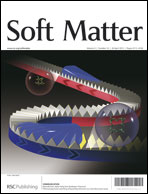Dynamics and growth of droplets close to the two-phase coexistence curve in fluids
Abstract
Results from state-of-the-art molecular dynamics simulations are presented for both equilibrium and nonequilibrium dynamics following a vapor–liquid transition in a single component Lennard-Jones system. We have fixed the overall density close to the vapor branch of the coexistence curve so that the liquid phase forms droplet structures in the background of the vapor phase. In the equilibrium case, the motion of a single droplet is studied in both microcanonical and canonical ensembles, in the latter case a hydrodynamics preserving Nosé–Hoover thermostat was used to control the temperature. The droplet nucleation, motion, collision and coalescence dynamics in the nonequilibrium case were studied in the canonical ensemble with the Nosé–Hoover thermostat. There it was observed that the average droplet volume grows linearly with time. Between two successive collisions, the size of the droplets remains the same even though all the constituent particles do not move with the droplets – some leave, others join. It is seen that the number of original particles in a droplet decays exponentially fast. Results from a liquid–liquid transition are also presented in the equilibrium context. Dynamics of droplets in equilibrium appears to be at variance with the nonequilibrium case.


 Please wait while we load your content...
Please wait while we load your content...